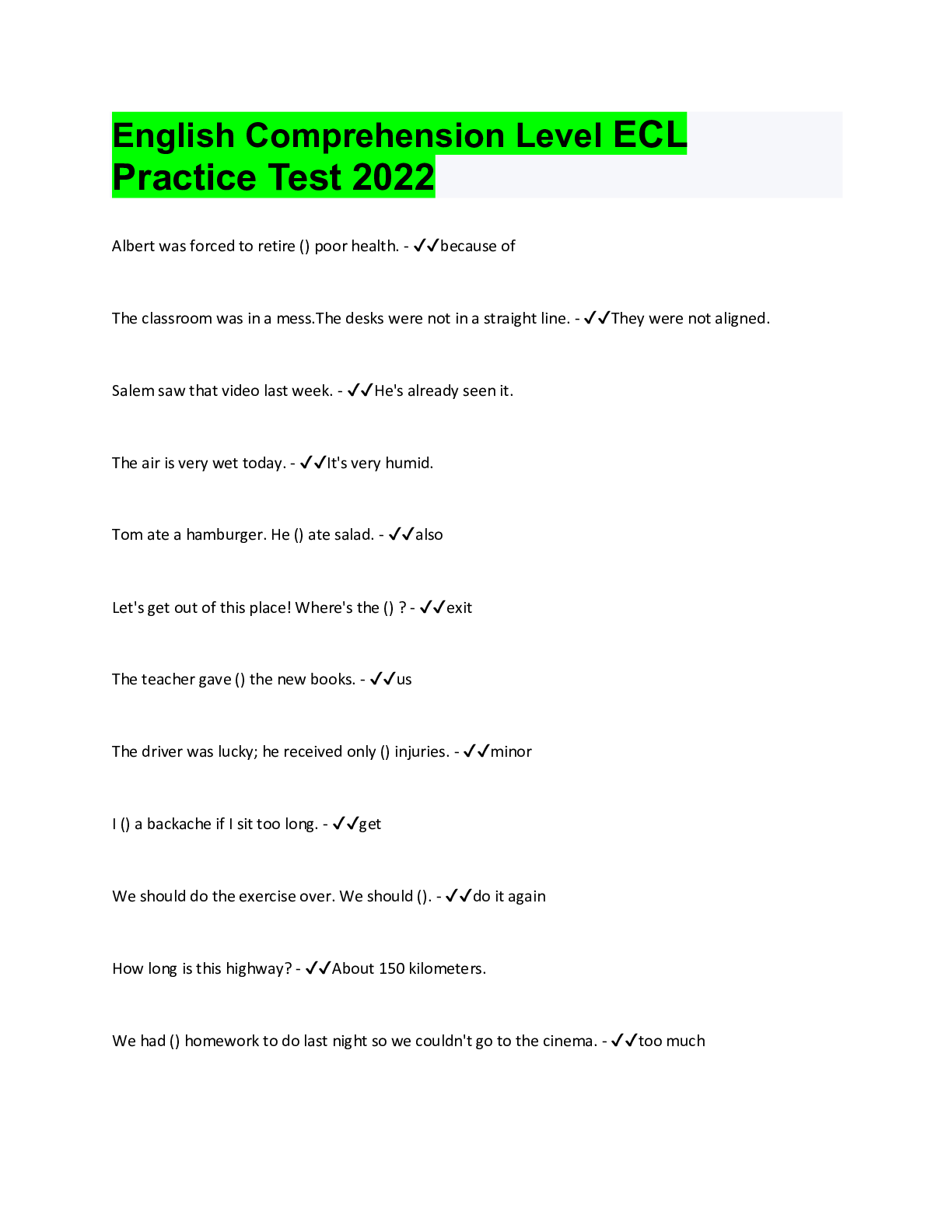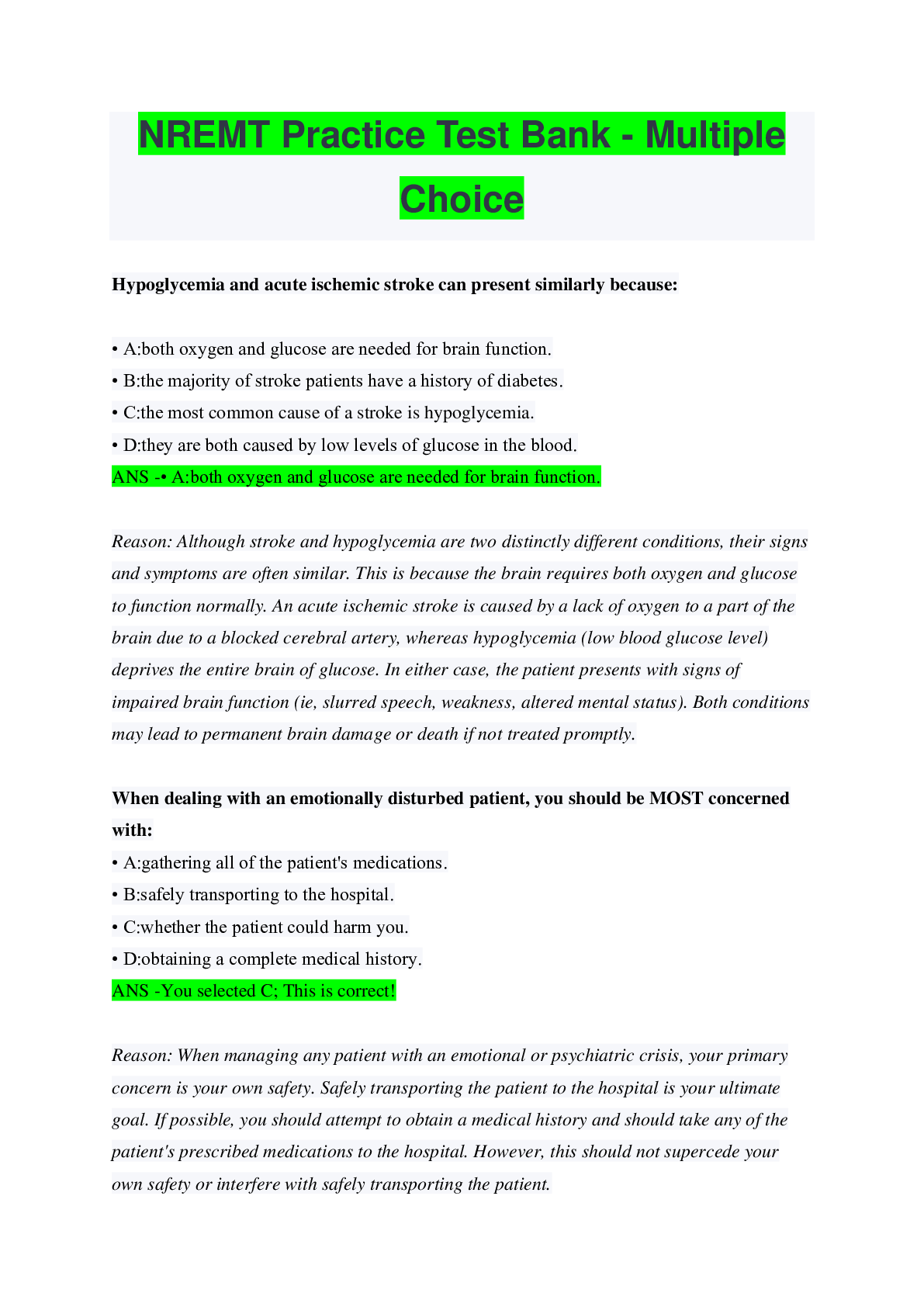*NURSING > QUESTIONS & ANSWERS > Nursing School Entrance Exams Prep Practice Test Two, Kaplan. With Answer Key and Answer Explanatio (All)
Nursing School Entrance Exams Prep Practice Test Two, Kaplan. With Answer Key and Answer Explanations
Document Content and Description Below
READING COMPREHENSION Questions 1–2 are based on the following passage. Until quite recently, hypnosis has been a specialized—and often controversial—technique used only in marginal areas of m... edicine. However, hypnosis is now increasingly finding mainstream use. For example, mental health experts have found that the suggestions of a skilled therapist are often remarkably effective in countering anxiety and depression. The benefits of hypnosis, though, are not limited to the emotional and psychological realm. Hypnosis helps burn center patients manage excruciating pain, and a recent research study found that hypnosis can dramatically shorten the time required for bone fractures to heal, often by several weeks. 1. Which answer option BEST expresses the main idea of the passage? (A) Hypnosis has become established as one of the most effective means to manage pain. (B) Despite its controversial history, hypnosis has proven useful across many areas of medicine. (C) Hypnosis remains controversial, especially when used to treat anxiety and depression. (D) The benefits of hypnosis have been shown to be limited to certain areas, but nonetheless effective. 2. Which term or phrase best defines the word manage as it is used in the passage? (A) Direct. (B) Administer. (C) Bring about. (D) Cope with. Questions 3–4 are based on the following passage. In recent years, shark attacks in U.S. waters have received wide attention. Are such attacks a growing threat to swimmers and surfers? Statistics suggest not. The rate of attacks per number of swimmers has not increased over time. What has increased is the popularity of aquatic sports, such as surfing, sail boarding, and kayaking. More people are in the water these days, and therefore the chances of a shark encounter increase. Still, to keep the issue in perspective we should remember there were only six fatal shark attacks in U.S. coastal waters from 1990 to 2000. 3. According to the author, which of the following has NOT increased over time? (A) The total number of shark attacks in U.S. waters. (B) The popularity of aquatic sports. (C) The number of fatal shark attacks in U.S. coastal waters. (D) The rate of shark attacks per number of people in the water. 4. Why does the author MOST likely provide the statistic in the final sentence? (A) To point out that U.S. coastal waters are safer than those of other countries. (B) To illustrate that relatively few fatal shark attacks have occurred in U.S. waters. (C) To show that the period 1990–2000 marked a decrease in the number of fatal shark attacks. (D) To caution swimmers and surfers against dangers. Questions 5–6 are based on the following passage. Although much about dolphin communication remains a mystery, scientists have discovered three distinct sounds that dolphins frequently make: chirps, clicks, and whistles. Scientists have learned that dolphins use clicks to create a sonar map, which allows them to navigate and hunt. But, apart from possibly transmitting location, the clicks do not appear to serve any communication purpose. Rather, research indicates that dolphins communicate with each other by whistling. This discovery has necessitated further investigation, as scientists are not yet sure whether the whistles comprise a complex system of linguistic communication or a simple set of sonic cues like the ones used by other animal species. 5. Why does the author mention whistles in the passage? (A) To show that dolphins are capable of expressing emotion. (B) To prompt questions about the complexity of dolphin communication. (C) To illustrate how they aid dolphins in navigating and hunting. (D) To continue to spur research into their unknown purpose. 6. Which is implied about dolphins in the passage? (A) They are not the only animal species that communicates sonically. (B) They never use clicks for communication. (C) They are more intelligent than other animal species. (D) They use a system of communication similar to that of other animal species. Questions 7–12 are based on the following passage. Until recently, patients with progressive diseases that eventually lead to blindness have had little in the way of treatment, let alone a cure. Conditions such as retinitis pigmentosa and macular degeneration still stump doctors, and even the latest treatments, such as prescribing massive doses of vitamin A, only temporarily slow the progress of the disease in some patients. Currently, there is no failsafe way to reverse or even stop the progress of these diseases. Mechanical devices such as retinal implants seem to work with only a limited number of patients—really, only those whose vision loss is caused by a retinal disorder. However, one new treatment is showing some promise, although it hasn’t been thoroughly tested yet. Instead of focusing on dietary solutions, some doctors are attempting to develop an electronic one: a bionic eye that enables the user’s brain to translate light impulses and create a virtual black-and-white “picture” of his or her surroundings. The picture, although accurate, only reflects a very limited field of vision, as if the patient had blinders on. Also, the picture moves fairly slowly, as if the patient were watching a film in very slow motion. But, being able to locate and identify objects is a definite first step in achieving everyday functional mobility for the visually impaired. Rather than the glass eye one might imagine, this artificial vision system consists of an elaborate apparatus that looks like a pair of binoculars, as well as a series of wires that are implanted directly into the patient’s brain. The wires electrically stimulate the visual cortex, producing phosphenes, which blind people perceive as small points of light. The device then maps these phosphenes, gradually training the patient’s brain to “see.” One major advantage of the system, as opposed to other proposed treatments such as retinal implants, is that it is not condition-specific: Patients can use it regardless of the cause of vision loss. For example, patients with genetic conditions such as retinitis pigmentosa, as well as patients with vision loss resulting from illness or accident, can use the device, since it directly stimulates the brain’s vision center. In addition, its construction is fairly flexible and portable (the wires, in fact, are said to be hardly noticeable), and its utilities are far-reaching: One could envision a number of useful additional features, including zoom and night vision functions. 7. Why does the author MOST likely refer to retinal implants in paragraph 1? (A) To provide an example of an electronic artificial vision device. (B) To describe one way in which mechanical vision devices are limited. (C) To imply that all degenerative eye diseases are too advanced for most doctors. (D) To describe one extremely effective artificial vision device. 8. In paragraph 2, why does the author use the phrase definite first step to describe the bionic eye? (A) It hasn’t been thoroughly tested yet, and should not be viewed as a “cure” for blindness. (B) The device provides only limited vision, but it could be enough to improve mobility for users. (C) Advances in the bionic eye might lead to the development of more effective retinal implants. (D) It provides a viable alternative to dietary treatments. 9. In paragraph 3, what does the phrase functional mobility refer to? (A) The ability to perform daily activities. (B) The usefulness of electrical devices. (C) The ability to read road signs. (D) The theory that electrical vision devices work better than mechanical ones. 10. In the final paragraph, why does the author suggest that the uses of the bionic eye are far-reaching? (A) The device could be provided with capabilities beyond even those of normal eyesight. (B) A wide variety of visually impaired people could be treated with the device. (C) The device could be provided at a low cost for people all over the world. (D) Technological developments required for the bionic eye could kick-start other industries. 11. Which statement BEST expresses the main idea of the passage? (A) An artificial vision system will likely take many years to develop and refine and may prove to be too limited in its capabilities for most visually impaired people. (B) A “bionic” artificial vision system relies on electrical impulses to stimulate the user’s brain into “seeing.” (C) The development of a “bionic” artificial vision system could bring functional sight to people who previously had little hope of ever seeing again. (D) Some medical conditions that cause visual impairment are much more difficult to treat than visual impairments caused by injury. 12. Based on the passage, which statement is MOST likely true about macular degeneration? (A) It is a progressive disease that eventually leads to a complete loss of vision. (B) It is the most common cause of vision loss among the elderly. (C) It cannot be treated by a “bionic” artificial vision system. (D) It is more difficult to treat than retinitis pigmentosa. Questions 13–15 are based on the following passage. On a stormy June day in 1752, Benjamin Franklin carried out the famous experiment in which he channeled lightning down a kite string and stored the electric charge in a Leyden jar, the precursor to the modern capacitor. The consequences could not have been more pronounced. Franklin proved that electricity was a force of nature, like Newton’s gravity, and the subsequent invention of the lightning rod (based on Franklin’s theories) sharply reduced risk of fire to tall buildings. Franklin’s experiment had cultural repercussions as well. It showed that scientific research could have practical benefits, and it impugned the superstitious belief—widespread at the time—that lightning resulted from divine displeasure. 13. For which purpose does the author include the sentence, “The consequences could not have been more pronounced”? (A) To show that it was difficult to describe the results of the experiment. (B) To suggest that Franklin became famous because of the experiment. (C) To illustrate the importance of conducting experiments. (D) To stress that Franklin’s experiment had far-reaching effects. 14. Based on the passage, in which of these did Franklin’s kite experiment play a part? (A) Promoting superstitious beliefs. (B) Explaining the force of gravity. (C) Developing the Leyden jar. (D) Illustrating the utility of scientific research. 15. Which answer option best defines the word impugned as it is used in the passage? (A) Reinforced. (B) Cast doubt upon. (C) Popularized. (D) Called attention to. WRITING Questions 1–5 are based on the following passage. 1One of the hazards of swimming in the ocean is an unexpected encounter with a jellyfish. 2Contact with the poison in a jellyfish’s tentacles can result in sharp, lingering pain, or even death if the person stung is highly allergic. 3While everyone, including the jellyfish, would like to avoid these encounters, they are not uncommon. 4In fact, I was stung twice when I lived in Australia. 5This is hardly surprising considering that jellyfish lives in every ocean in the world and have done so for more than 650 million years. 6The animals are likely so widespread because of their extreme adaptability—they are quite hardy and can withstand a wide range of temperatures and conditions in their environment. 7Although a jellyfish sting is unpleasant, the mechanics behind the sting are fascinating. 8The jellyfish is able to administor its sting thanks to tiny organelles known as nematocysts. 9Each tentacle on a jellyfish can contain thousands of nematocysts. 10When a nematocyst is triggered generally by potential prey brushing against the surface of the tentacle, it fires out a tiny, sharp barb to pierce the skin of the prey and inject toxin. 11If hundreds or thousands of nematocysts are all triggered at once by a single victim, they can cause excruciating pain or even death. 1. Which answer option describes how to correct a punctuation error in the passage? (A) Change the comma after the word pain in sentence 2 to a semicolon. (B) Change the dash after the word adaptability in sentence 6 to a comma. (C) Add a comma after the word triggered in sentence 10. (D) Change the comma after the word victim in sentence 11 to a colon. 2. Which sentence should be deleted because it provides unnecessary information? (A) Sentence 2. (B) Sentence 4. (C) Sentence 7. (D) Sentence 9. 3. Which word in paragraph 2 is incorrect? (A) Unpleasant. (B) Administor. (C) Potential. (D) Excruciating. 4. Where is the BEST place to add this sentence? Nematocysts are only found in sea organisms such as jellyfish, corals, and sea anemones. (A) Following sentence 4. (B) Following sentence 7. (C) Following sentence 8. (D) Following sentence 11. 5. Which sentence has incorrect subject-verb agreement? (A) Sentence 3. (B) Sentence 5. (C) Sentence 8. (D) Sentence 10. Questions 6–10 are based on the following passage. 1In addition to being the largest planet in the Solar System, Jupiter holds the distinction of having the most moons of any planet in the Solar System. 2Currently, 69 celestial objects are recognized as moons of Jupiter. 3The four earliest of these to be discovered were, not surprisingly, the largest: Callisto, Europa, Ganymede, and Io. 4They are collectively known as the Galilean satellites because they were first identified by astronomer Galileo Galilei in 1610. 5Galileo is recognized as one of the most important figures in the development of physics and the scientific method, but he spent many years under house arrest because he was accused of heresy by the Roman Catholic Church. 6The four Galilean satellites of Jupiter probably experienced early, intense bombardment by other celestial objects. 7Thus, the very ancient surface of Callisto remains scarred by impact craters. 8The younger, more varied surface of Ganymede reveals distinct light and dark areas, the light areas featuring networks of intersecting grooves and ridges, probably resulting from later iceflows. 9The impact sites of Europa have been almost completely erased; apparently by water outflowing from the interior and instantly forming vast, low, frozen seas. 10Satellite photographs of Io, the closest of the four to Jupiter, were revelatory. 11They showed a landscape dominated by volcanos, many actively erupting, making Io the most tectonically active object in the solar system. 12Since a body as small as Io cannot supply the energy for such a notable affect, the accepted explanation has been that, forced into a highly excentric orbit, Io is engulfed by tides stemming from a titanic contest between the other three Galilean moons and Jupiter. 6. Which word in paragraph 2 is incorrect? (A) Bombardment. (B) Intersecting. (C) Apparently. (D) Excentric. 7. Which sentence includes an unnecessary word? (A) Sentence 2 includes the unnecessary word currently. (B) Sentence 7 includes the unnecessary word very. (C) Sentence 8 includes the unnecessary word probably. (D) Sentence 11 includes the unnecessary word many. 8. Which sentence should be deleted because it provides unnecessary information? (A) Sentence 2. (B) Sentence 4. (C) Sentence 5. (D) Sentence 8. 9. Which sentence contains an error in punctuation? (A) Sentence 3. (B) Sentence 5. (C) Sentence 9. (D) Sentence 12. 10. Which word is incorrect in its sentence? (A) The word distinction in sentence 1. (B) The word collectively in sentence 4. (C) The word revelatory in sentence 10. (D) The word affect in sentence 12. Questions 11–14 are based on the following passage. 1Coral reefs are created over the course of hundreds or even thousands of years. 2The main architect in coral reef formation is the stony coral, a relative of sea anemones that lives in tropical climates and secretes a skeleton, of almost pure calcium carbonate. 3It is partnered by green algae, tiny unicellular plants that live within the tissues of coral. 4The two organisms form a mutually benificial, symbiotic relationship, with the algae consuming carbon dioxide given off by the coral, and the coral thriving on the abundant oxygen produced photosynthetically by the algae. 5When the coral dies, its skeleton is left, and other organisms grow on top of it; some estimates suggest that coral reefs provide habitat for around one-fourth of all marine species in the world. 6Over the years, the mass of the coral skeletons and the associated organisms combine to form the petrified underwater forest that divers find so fascinating. 7In the United States alone, over three million people go scuba diving every year. 8The largest coral reef system in the world, the Great Barrier Reef, is found off the northeastern coast of Australia. 9It covers an area of more than 100,000 square miles. 10Although much of the reef is protected as a marine park by the Australian government, some scientists fear that such protection could prove futile in the face of global climate change. 11According to researchers, between 1985 and 2012, the Great Barrier Reef has lost more than half of it’s total coral cover, with warmer ocean temperatures shouldering much of the blame for the dramatic loss. 11. Which sentence should be deleted because it provides unnecessary information? (A) Sentence 3. (B) Sentence 7. (C) Sentence 9. (D) Sentence 11. 12. Which word in paragraph 1 is incorrect? (A) Secretes. (B) Benificial. (C) Abundant. (D) Petrified. 13. Which choice describes how to correct a punctuation error in the passage? (A) Add a comma after the word hundreds in sentence 1. (B) Remove the comma after the word skeleton in sentence 2. (C) Replace the semicolon after the word it in sentence 5 with a comma. (D) Replace the comma after the word cover in sentence 11 with a semicolon. 14. Which word is incorrect in its sentence? (A) The word lives in sentence 2. (B) The word species in sentence 5. (C) The word futile in sentence 10. (D) The word it’s in sentence 11. MATHEMATICS 1. If , then x equals which answer choice? (A) (B) 4 (C) 6 (D) 8 2. A worker earns $16 per hour for the first 40 hours she works each week, and one and a half times this much for every hour over 40 hours. If she earned $700 for one week’s work, how many hours of overtime did she work? (A) 3.3 (B) 3 (C) 2.5 (D) 4 3. A nurse must mix a 20% solution of a medication in an existing container of water. If the container currently holds 12 ounces of water, how many ounces of medication should the nurse add to make the proper solution? (A) 2.5 (B) 3 (C) 3.6 (D) 4 4. 23(3 − 1)2 + (−4)2 = ? (A) 48 (B) 32 (C) 136 (D) −48 5. Ruth has finished 3 chapters of an 8-chapter novel in just one evening of reading. If she reads an additional of the novel tomorrow night, what part of the novel will she have finished? (A) (B) (C) c (D) 6. If 90 ÷ x = 9n, then what is the value of nx? (A) 10 (B) 9x (C) 900 (D) 90xn 7. (A) (B) (C) (D) 8. A machine labels 150 bottles in 20 minutes. At this rate, how many minutes does it take to label 60 bottles? (A) 2 (B) 4 (C) 6 (D) 8 9. If a woman earns $600 for her first 40 hours of work in a week and then is paid one-and one-half times her regular rate for any additional hours, how many hours must she work to make $690 in a week? (A) 43 (B) 44 (C) 45 (D) 46 10. In a group of 25 students, 16 are female. What percent of the group is female? (A) 16% (B) 40% (C) 60% (D) 64% 11. If a barrel has the capacity to hold 75 gallons, how many gallons does it contain when it is full? (A) 45 (B) 48 (C) 54 (D) 60 12. If 13 + a = 25 + b, then b − a = ? (A) 38 (B) 12 (C) 8 (D) −12 13. If a kilogram is equal to approximately 2.2 pounds, which of the following is the best approximation of the number of kilograms in one pound? (A) (B) (C) (D) 14. Brad bought a music player on sale at a 20% discount from its regular price of $118. If there is an 8% sales tax that is calculated on the sale price, how much did Brad pay for the music player? (A) $86.85 (B) $94.40 (C) $101.95 (D) $127.44 15. If the ratio of males to females in a group of students is 3:5, which of the following could be the total number of students in the group? (A) 148 (B) 150 (C) 152 (D) 154 16. If 48 of the 60 seats on a bus were occupied, what percent of the seats were not occupied? (A) 12% (B) 15% (C) 20% (D) 25% 17. A delivery service charges $25.00 per pound for making a delivery. If there is an additional 8% sales tax, what is the cost of delivering an item that weighs of a pound? (A) $20.00 (B) $21.60 (C) $22.60 (D) $24.00 SCIENCE 1. Which is a function of bone? I. Formation of blood cells. II. Protection of vital organs. III. Framework for movement. (A) I only. (B) II only. (C) III only. (D) I, II, and III. 2. The rate of breathing is controlled by involuntary centers in which part of the brain? (A) Cerebrum. (B) Cerebellum. (C) Medulla oblongata. (D) Spinal cord. 3. Which phrase accurately describes the function of the hormone oxytocin? (A) Increases uterine contractions during childbirth. (B) Stimulates the release of glucose to the blood. (C) Induces water resorption in the kidneys. (D) Prepares the uterus for implantation of the fertilized egg. 4. Which blood type can be donated to anyone? (A) A (B) B (C) O (D) AB 5. Where in the body is insulin created? (A) Adrenal glands. (B) Kidneys. (C) Pancreas. (D) Thymus. 6. Which is the term for the tough elastic tissues found in the joints that connect bones to bones? (A) Ligaments. (B) Tendons. (C) Cartilage. (D) Muscles. 7. In which part of the eye are the light-sensitive cells known as rods and cones located? (A) Cornea. (B) Iris. (C) Pupil. (D) Retina. 8. Which muscle is controlled by conscious thought? (A) Smooth. (B) Striated. (C) Cardiac. (D) All of the above. 9. Where are most of the nutrients in food absorbed? (A) Stomach. (B) Pylorus. (C) Small intestine. (D) Large intestine. 10. Which statement about red blood cells in adult humans is true? (A) They have no nucleus. (B) They are replaced in the liver. (C) They are outnumbered by white blood cells in the circulatory system. (D) They are generated in the spleen. 11. If a patient diagnosed with diabetes mellitus accidentally overdosed on insulin, which would be likely to occur? (A) Increased levels of glucose in the blood. (B) Increased glucose concentration in urine. (C) Dehydration due to increased urine excretion. (D) Increased conversion of glucose to glycogen. 12. Saliva in the mouth begins the process of breaking down which of these? (A) Starch. (B) Fat. (C) Protein. (D) All of the above. 13. Which statement accurately describes the function of the hormone progesterone? (A) It increases human growth. (B) It stimulates the release of glucose to the blood. (C) It induces water resorption in the kidneys. (D) It prepares the uterus for implantation of the fertilized egg. 14. Which statement is true about dendrites? (A) They repair damaged neurons. (B) They exist only in the central nervous system. (C) They transmit nerve impulses away from the cell body. (D) They transmit nerve impulses toward the cell body. [Show More]
Last updated: 9 months ago
Preview 1 out of 32 pages
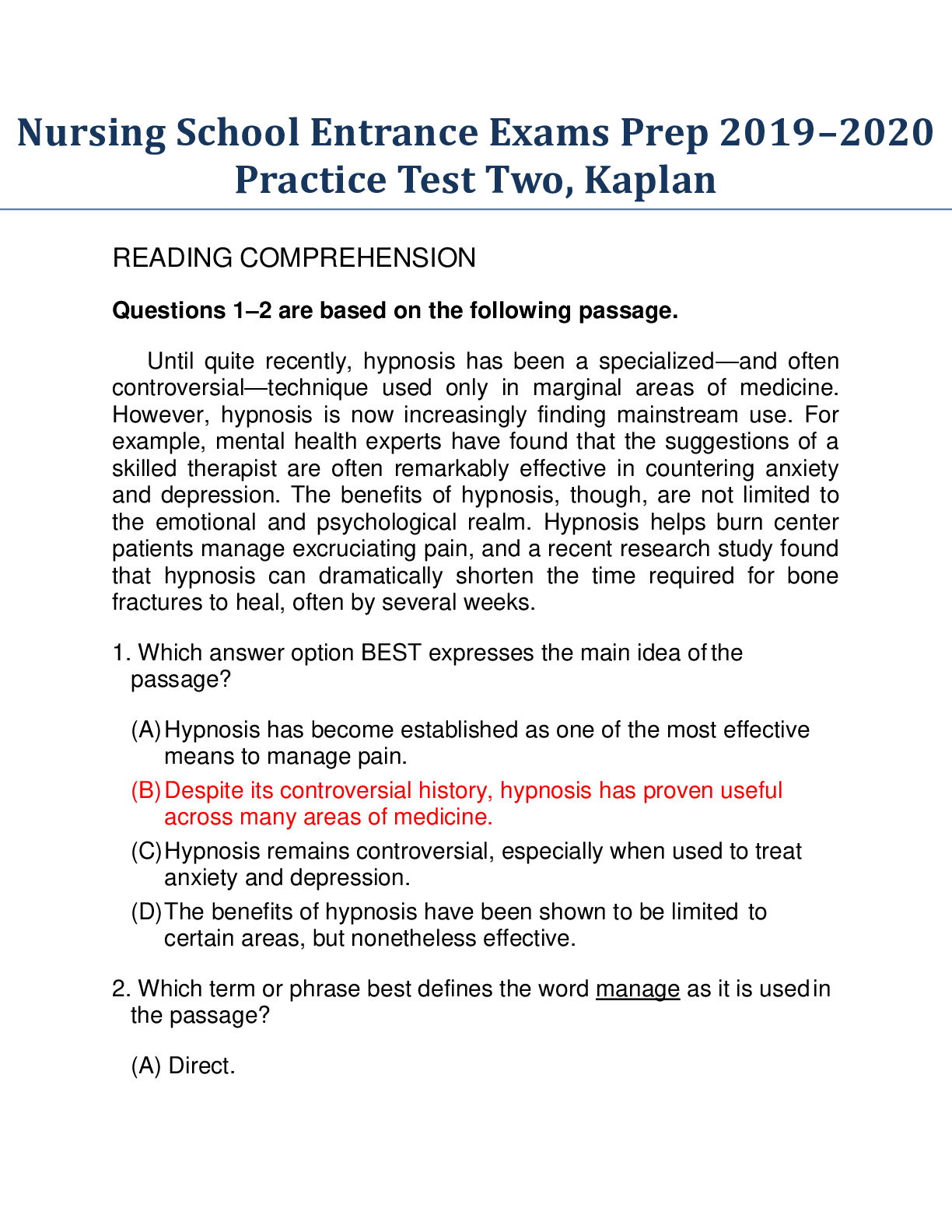
Document information
Connected school, study & course
About the document
Uploaded On
Jun 17, 2020
Number of pages
32
Written in
Additional information
This document has been written for:
Uploaded
Jun 17, 2020
Downloads
3
Views
228








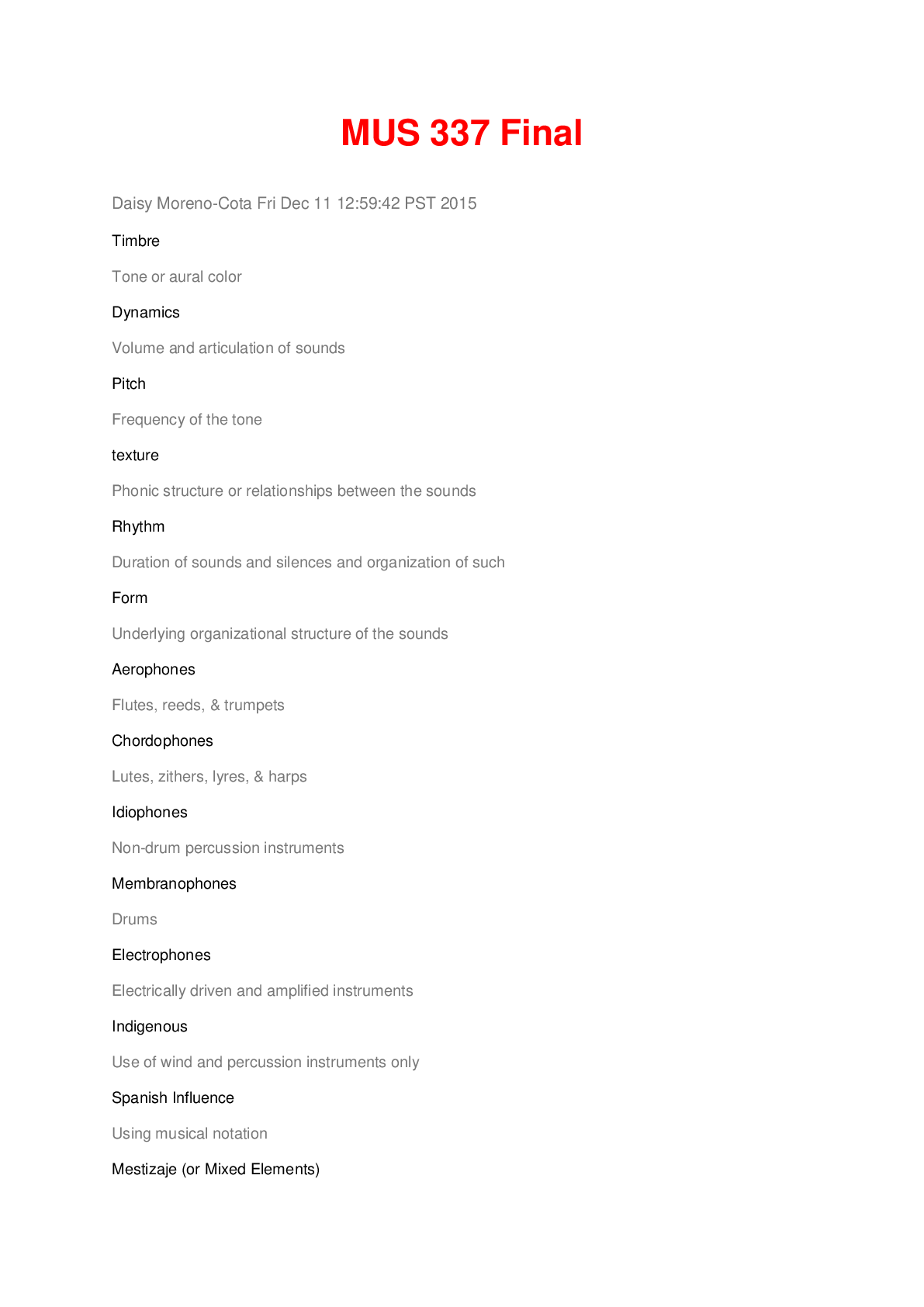




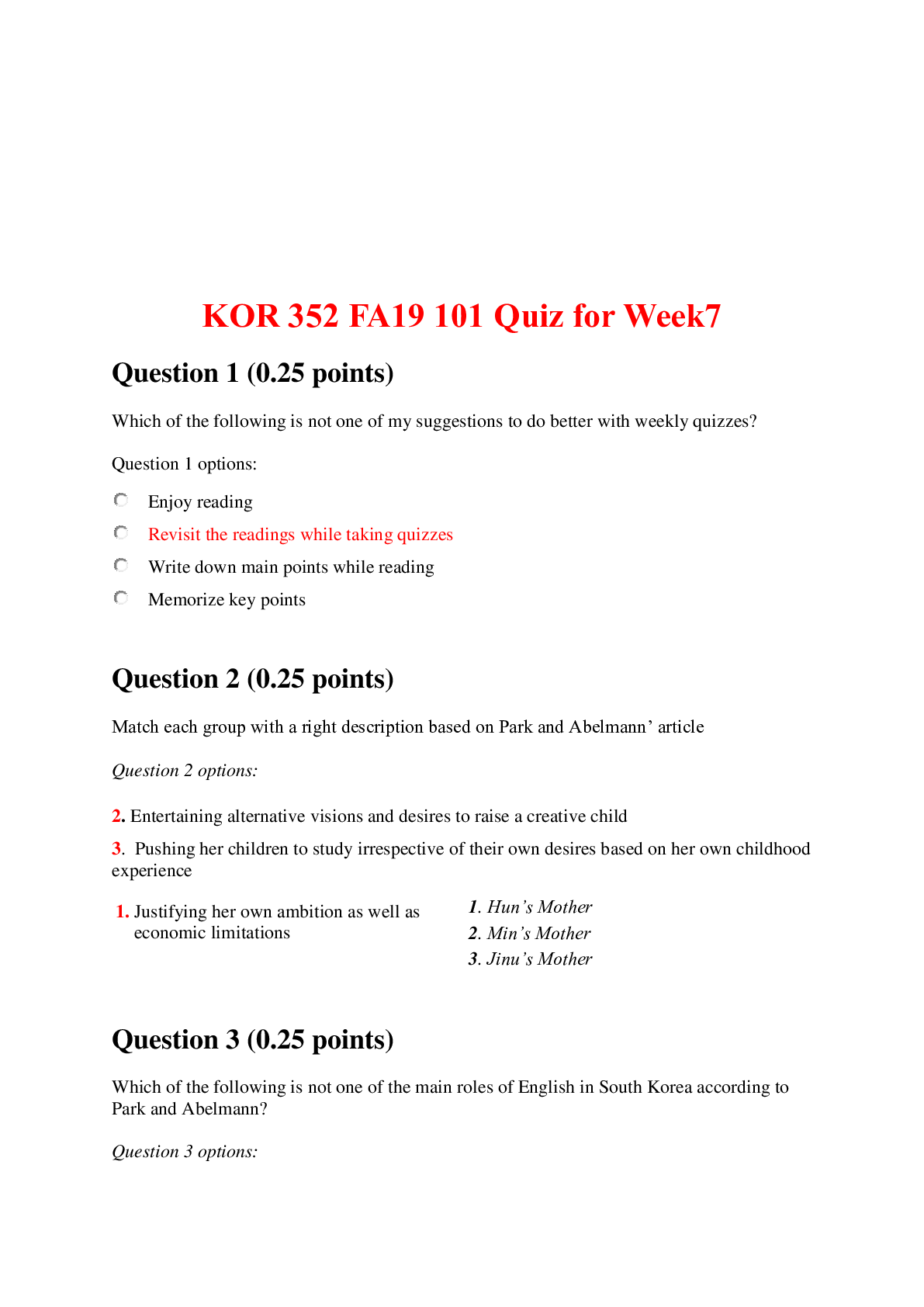


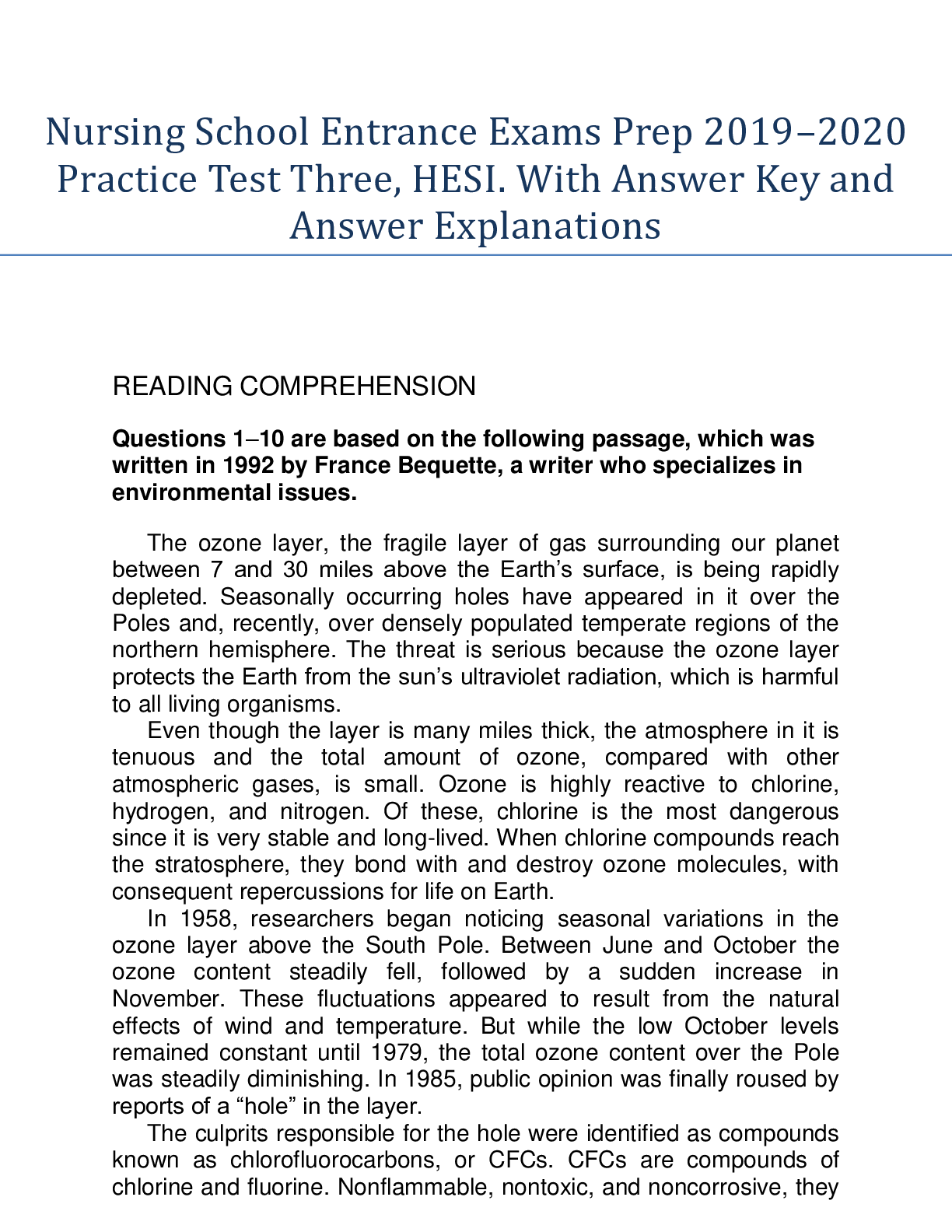
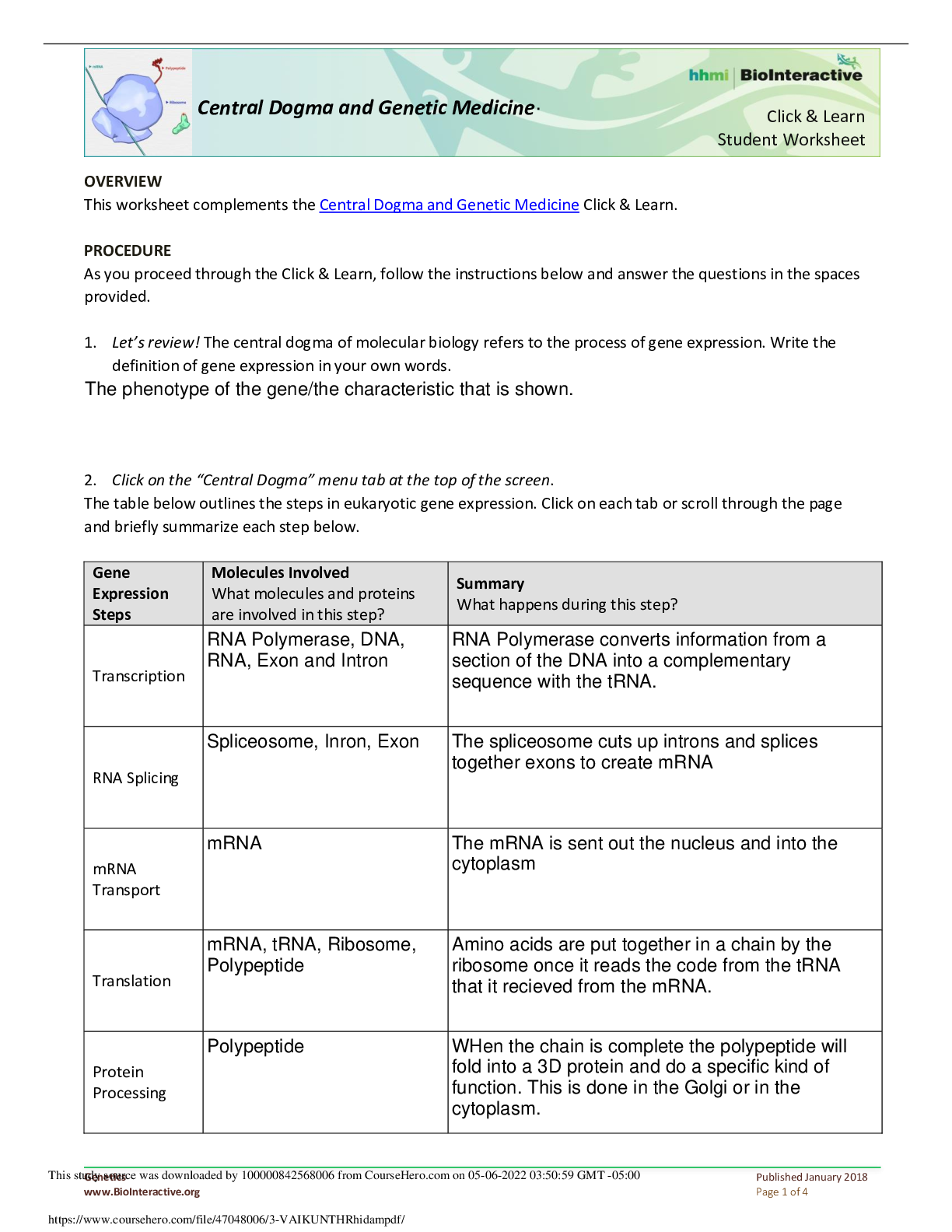

.png)
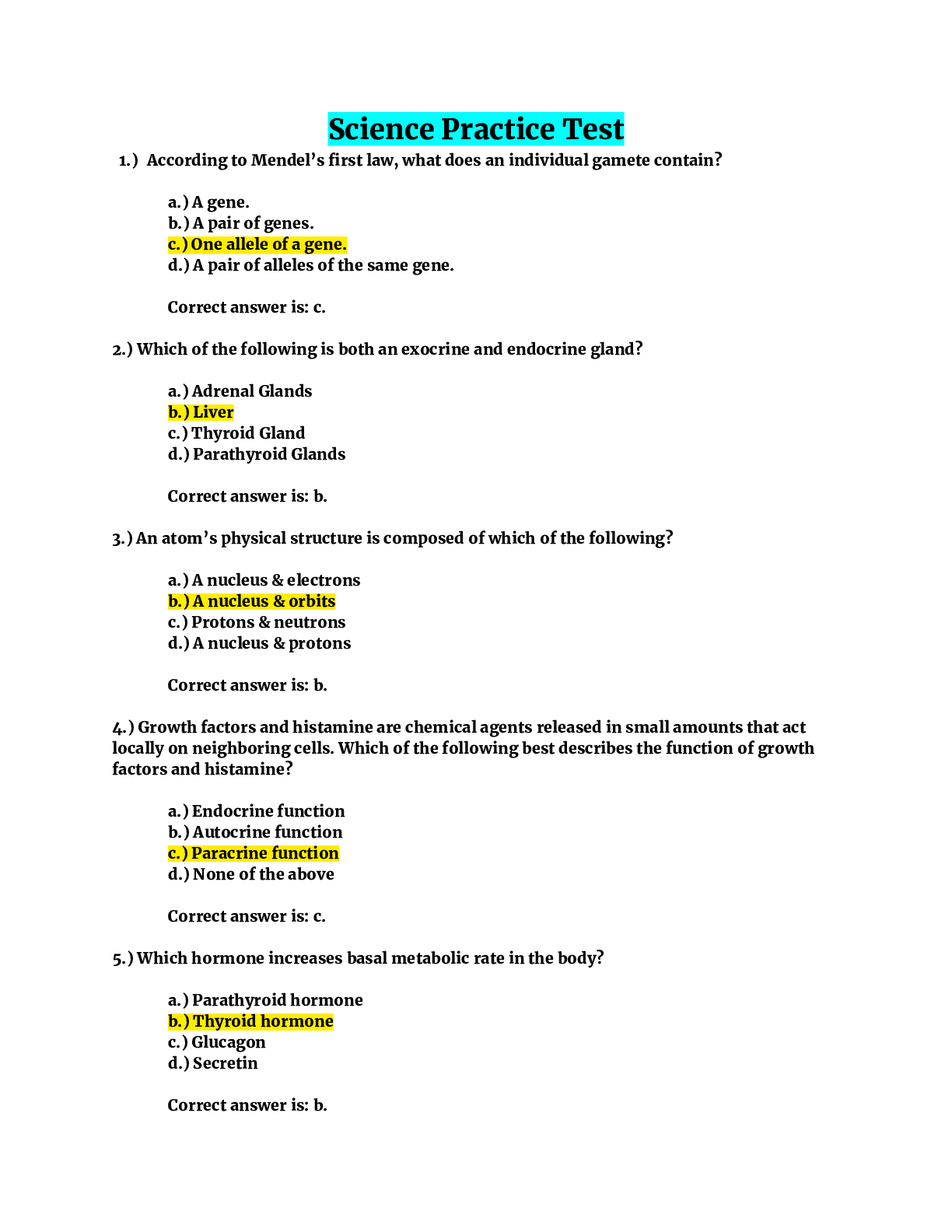
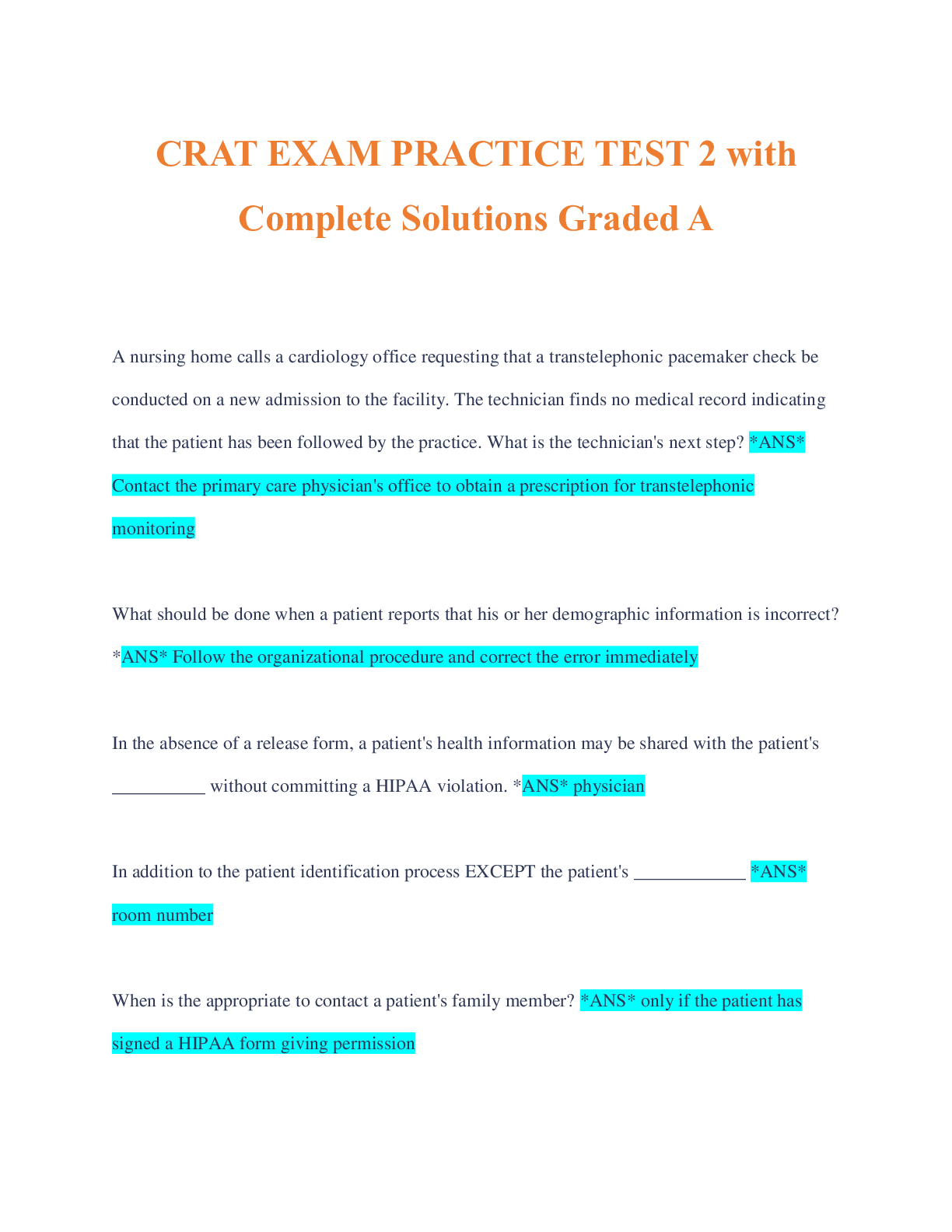
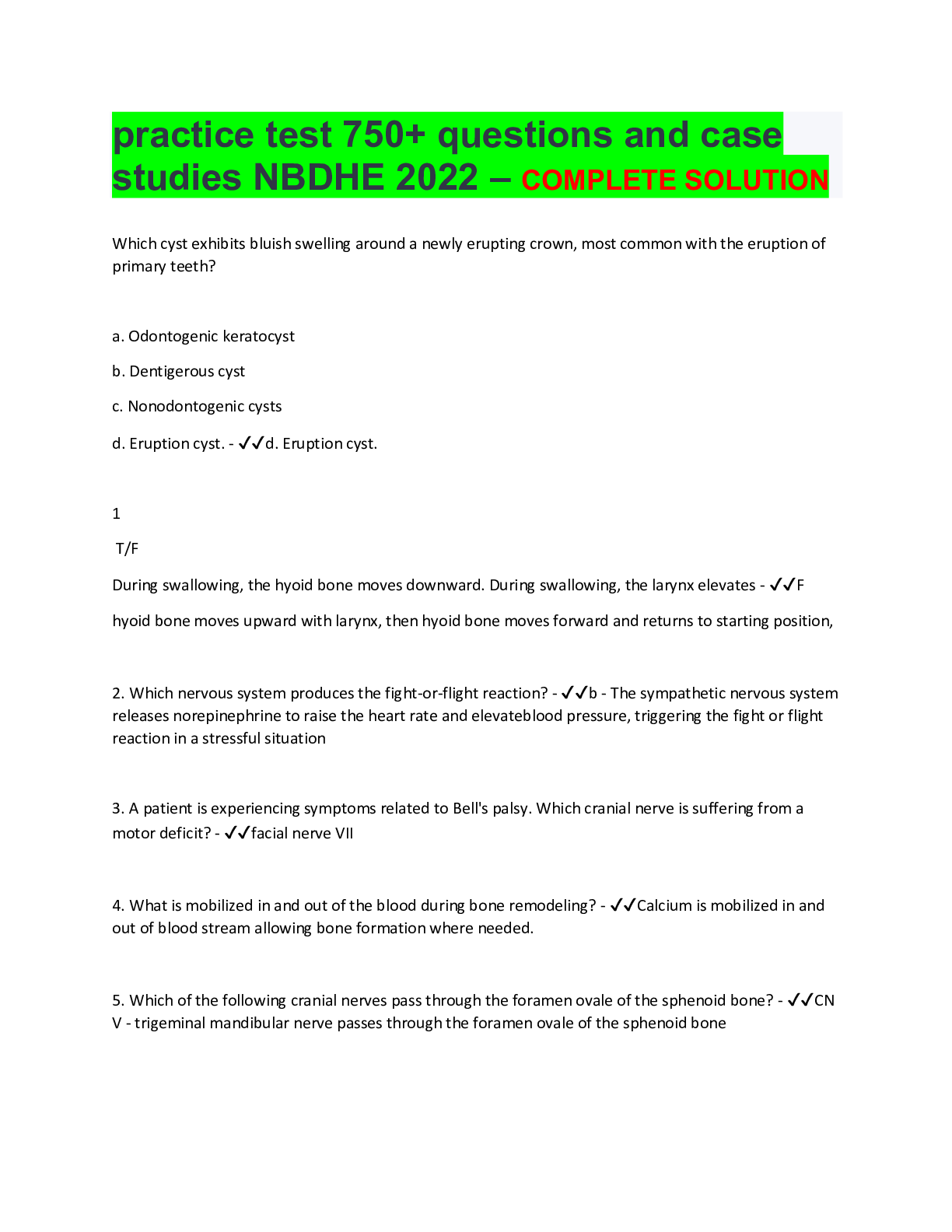
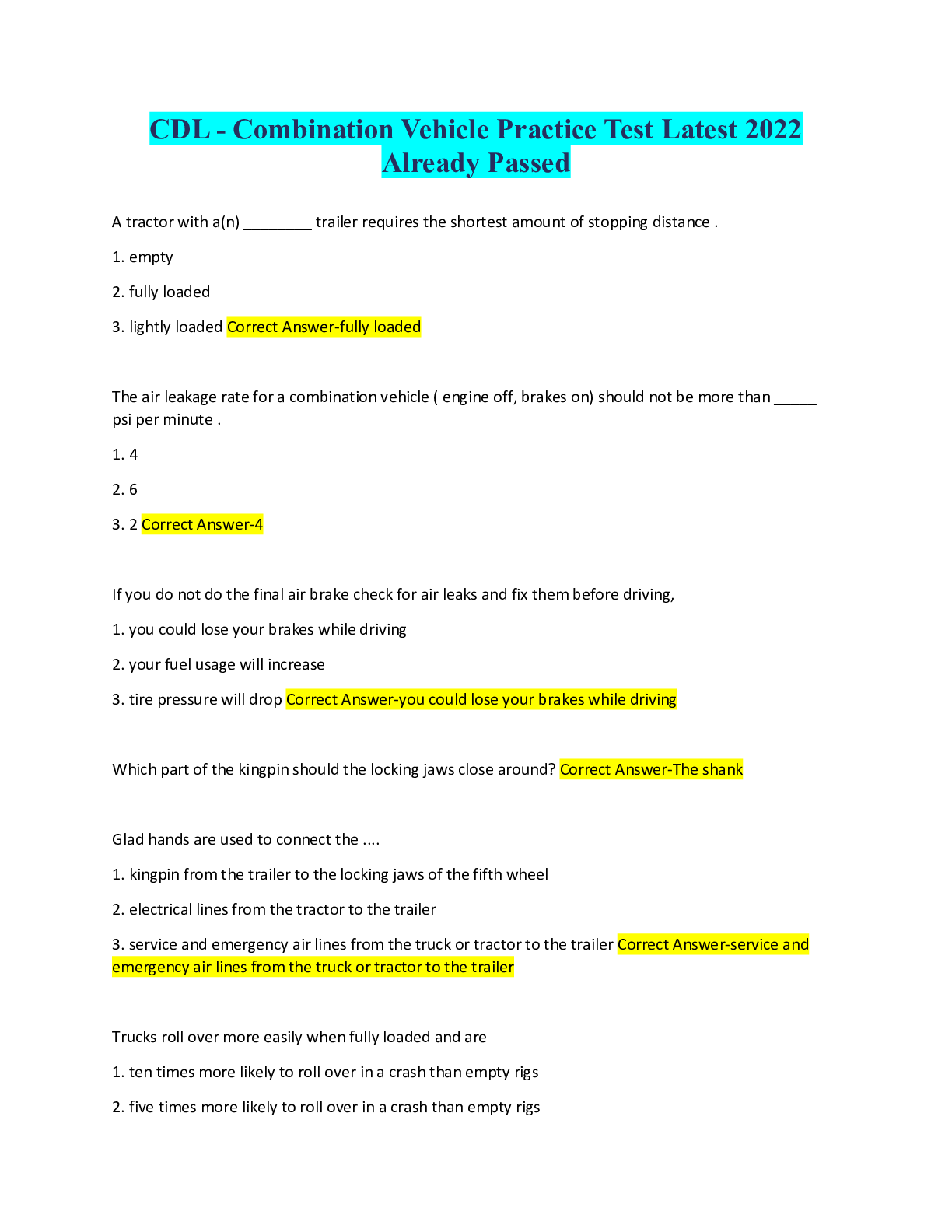

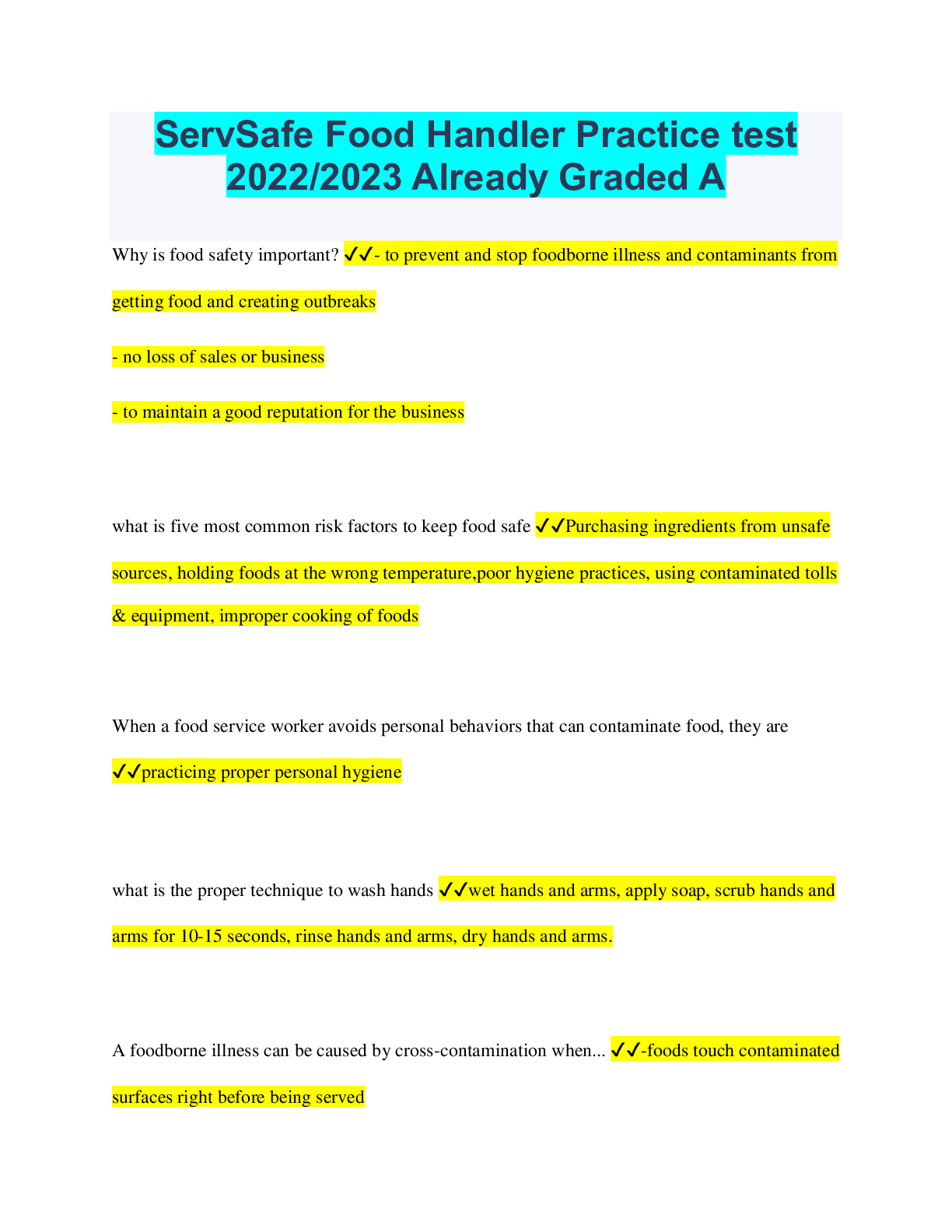

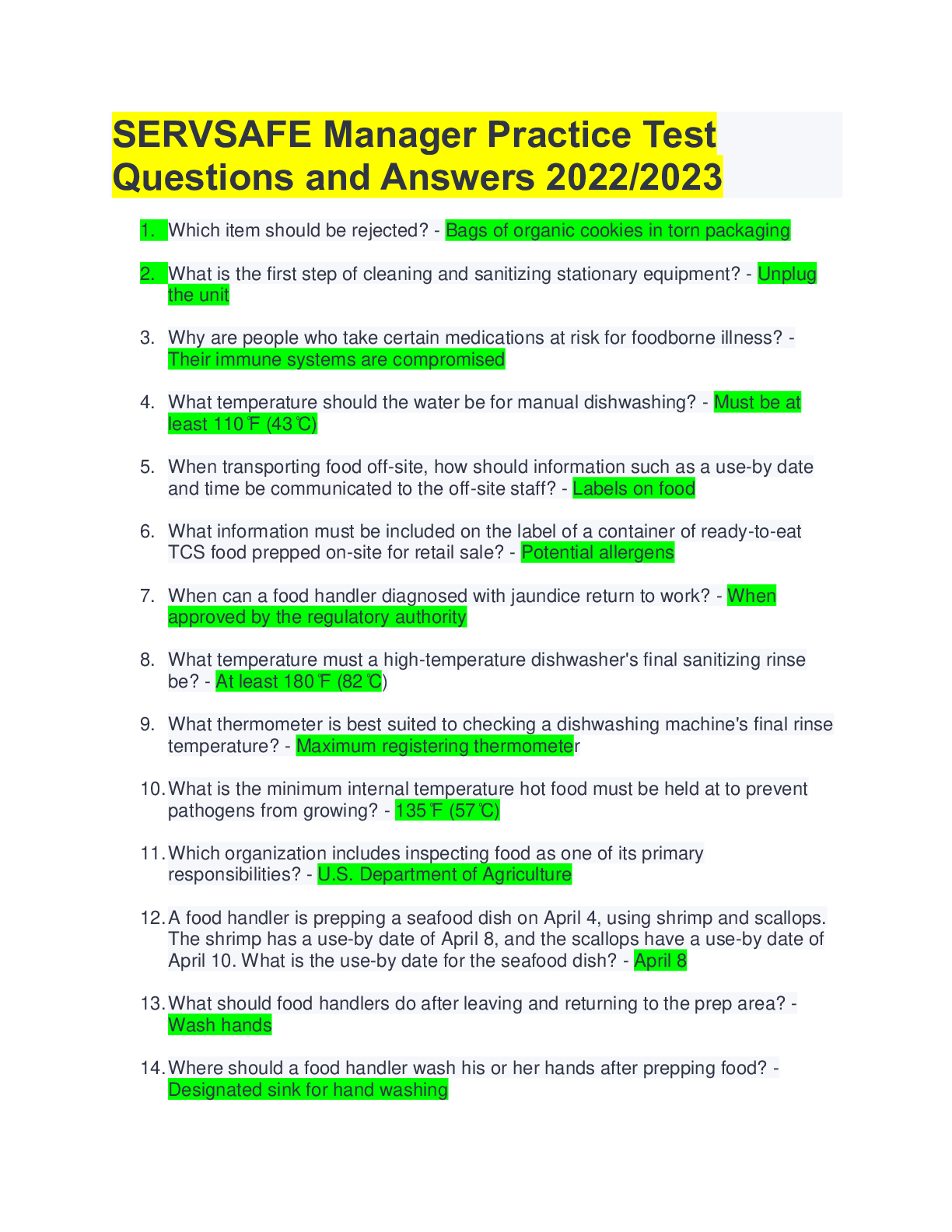
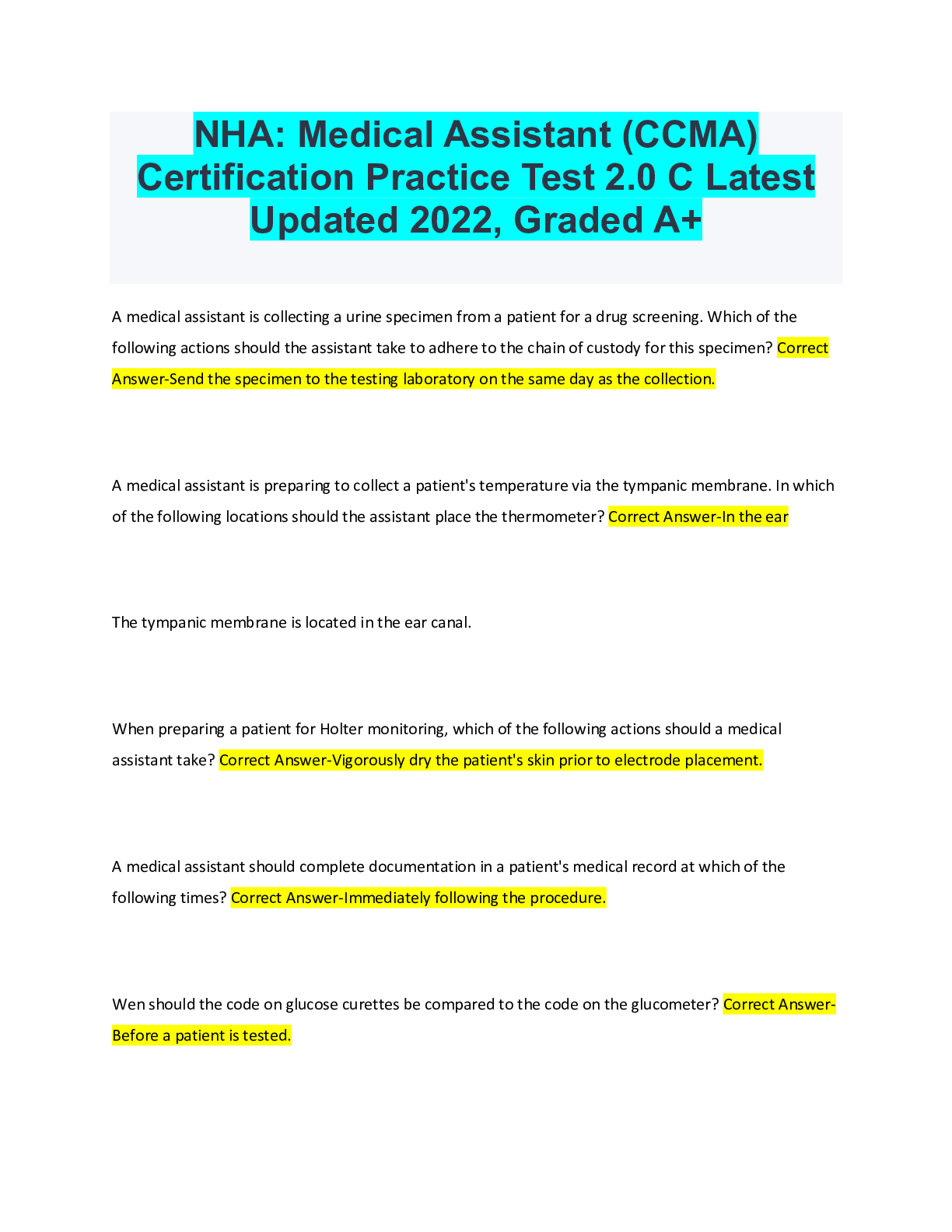
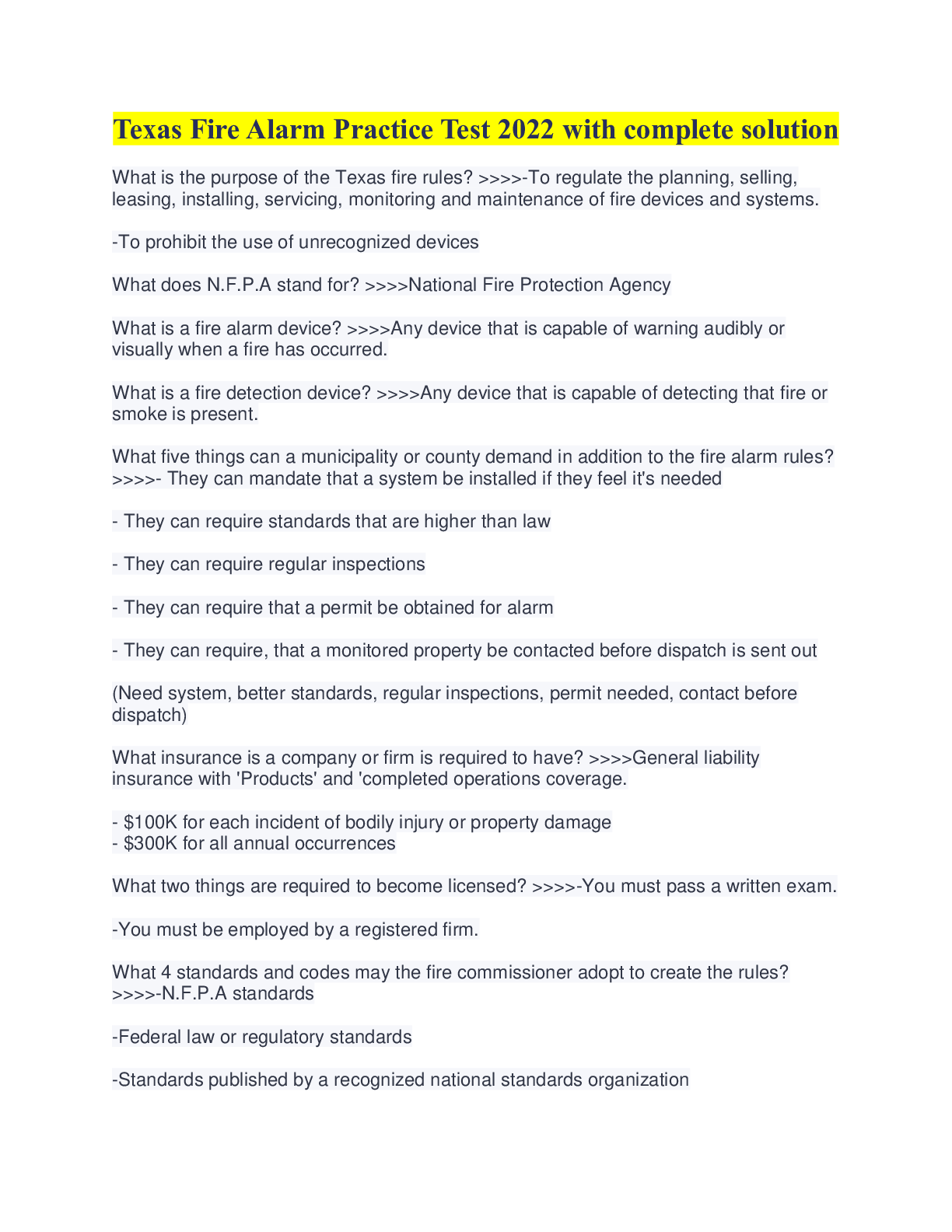

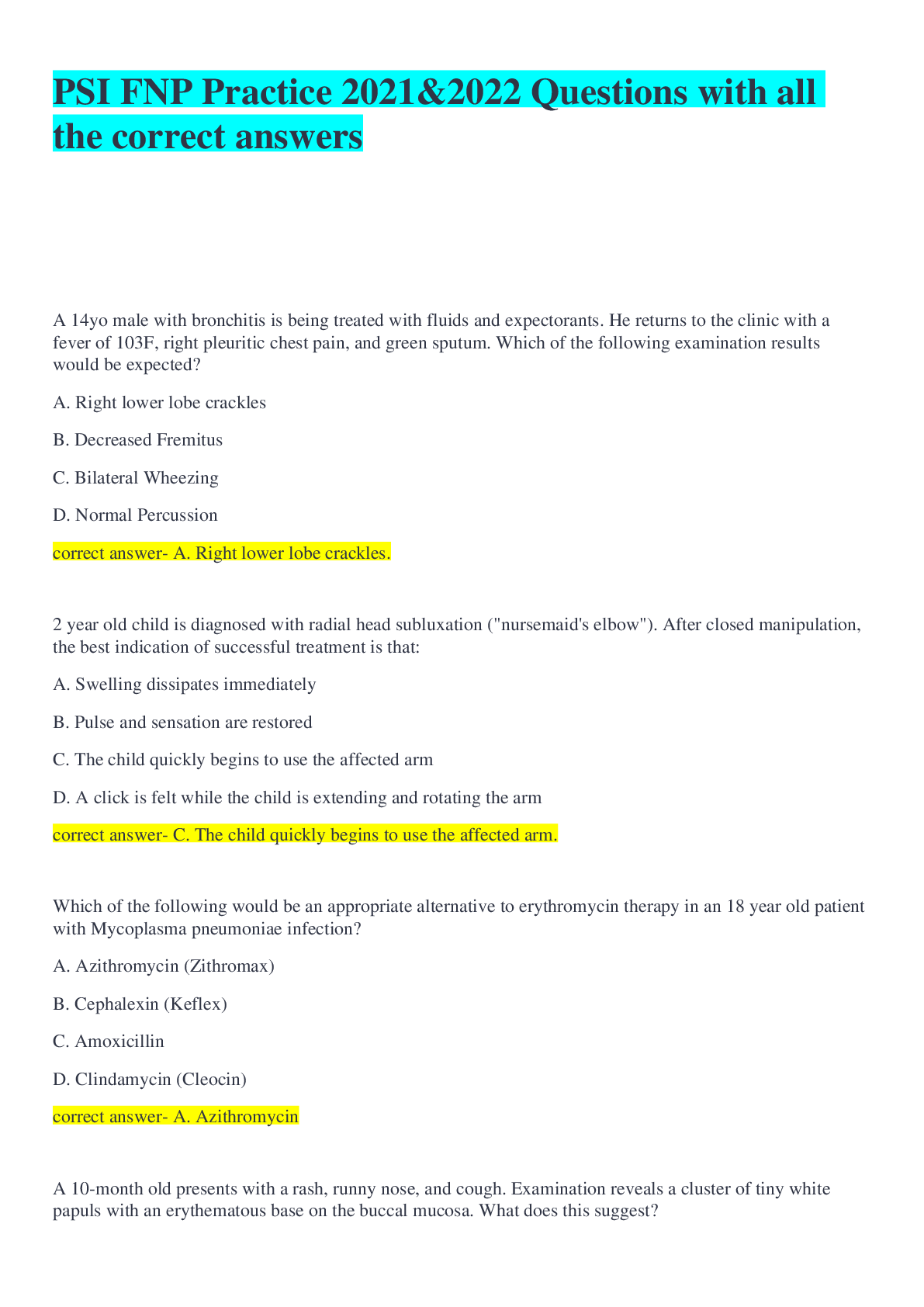
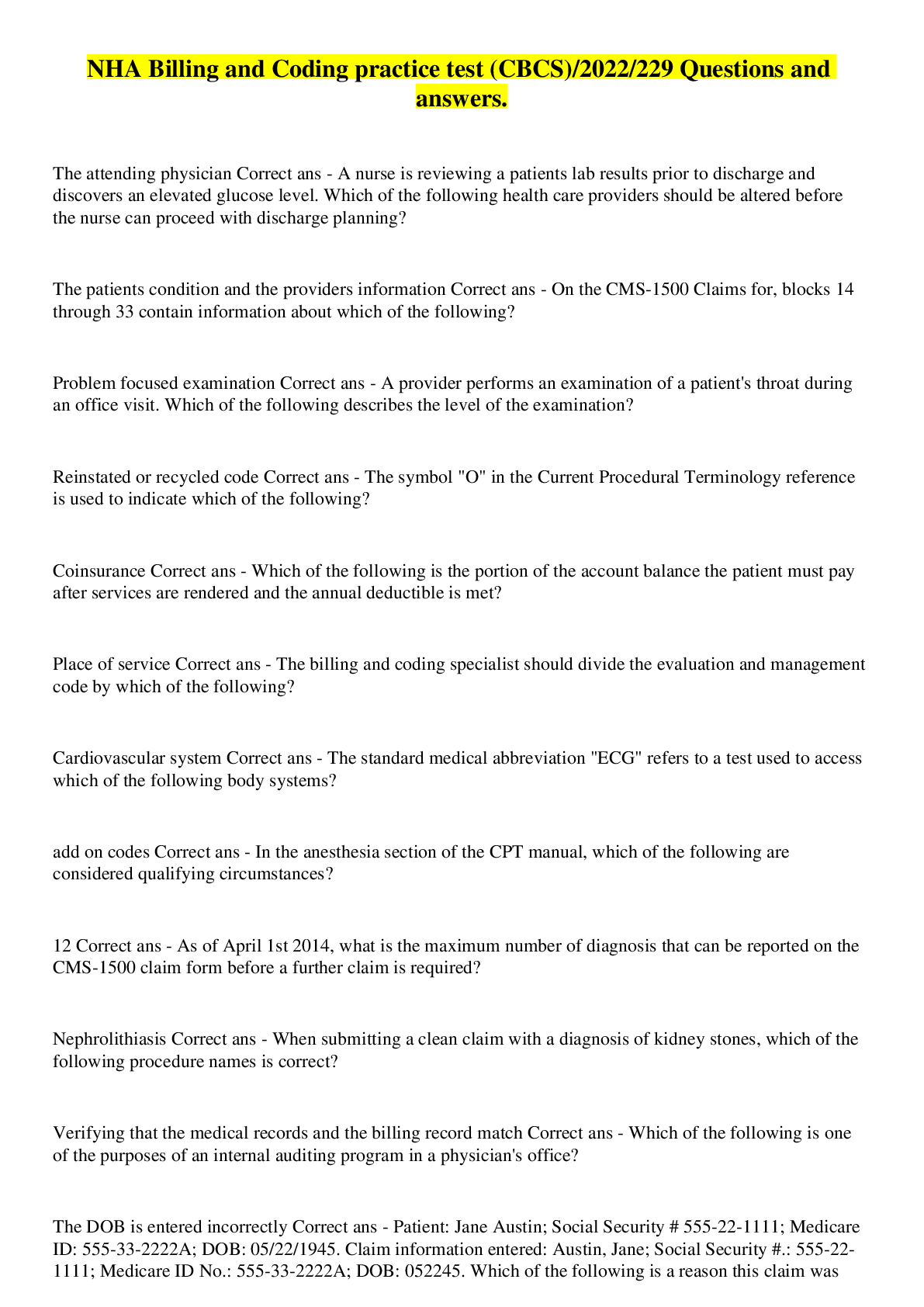
.png)
.png)
